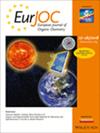A New Paradigm for the Supramolecular Structure of Laterally Offset Diarenes: Polymorphs II of Para‐Substituted Acetophenone Azines, YpPh(Me)CNNC(Me)PhYp (Y = Cl, Br, CH3)
IF 2.7
3区 化学
Q2 CHEMISTRY, ORGANIC
引用次数: 0
Abstract
The crystal structures of polymorphs II of acetophenone azines Y横向偏置双芳烃超分子结构的新范式:对取代苯乙酮Azines的多晶型II, Yp - Ph - (Me)C N - N C(Me) - Ph - Yp (Y = Cl, Br, CH3)
讨论了苯乙酮嘧啶Yp - Ph - RC N - N CR - Ph - Yp在R = CH3和Y = Cl (1M)、Br (2M)和CH3 (8M)下的多晶型II的晶体结构。多晶型II的azine分子与反式azine部分和控制苯基扭曲是对称的。多晶型1M‐I和2M‐I含有C2对称的对映体,具有明显的azine扭曲和dis旋苯基扭曲,并允许强的横向双T‐接触。这三种多晶II体现了“横向偏移diarenes”超分子结构的新范式IV,并产生了“shiplap/flat”独特的两亲单层。层内横向吸引是由分子之间具有大量纵向偏移的边对面芳烃接触提供的,涉及芳烃边缘桥接不同相邻的一个氮氮和一个苯基中心(EAzArB合成子)或一个苯基中心和取代基Y (EYArB合成子)。这些桥接合成子通过相关的结构参数进行了表征,并通过距离映射的Hirshfeld曲面分析和二维指纹图谱计算证实了它们的结构意义。边-面接触是分子间最吸引人的相互作用,这些相互作用通过计算的对相互作用能和芳香分析仪的分析结果来量化。通过确定合成子结合能和晶格能来评估多晶型的偏好能。
本文章由计算机程序翻译,如有差异,请以英文原文为准。
求助全文
约1分钟内获得全文
求助全文
来源期刊
CiteScore
5.40
自引率
3.60%
发文量
752
审稿时长
1 months
期刊介绍:
The European Journal of Organic Chemistry (2019 ISI Impact Factor 2.889) publishes Full Papers, Communications, and Minireviews from the entire spectrum of synthetic organic, bioorganic and physical-organic chemistry. It is published on behalf of Chemistry Europe, an association of 16 European chemical societies.
The following journals have been merged to form two leading journals, the European Journal of Organic Chemistry and the European Journal of Inorganic Chemistry:
Liebigs Annalen
Bulletin des Sociétés Chimiques Belges
Bulletin de la Société Chimique de France
Gazzetta Chimica Italiana
Recueil des Travaux Chimiques des Pays-Bas
Anales de Química
Chimika Chronika
Revista Portuguesa de Química
ACH—Models in Chemistry
Polish Journal of Chemistry.

 求助内容:
求助内容: 应助结果提醒方式:
应助结果提醒方式:


